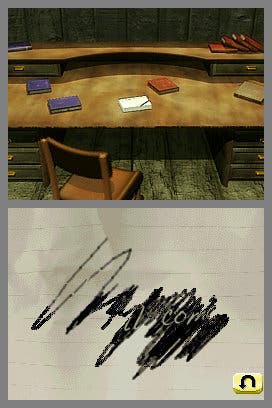Retrospective: Another Code - Two Memories
Remember this?
D is where the dual nature of the memories kicks in. Having died 57 years ago, D is the ghost of a boy about Ashley's age, with almost complete amnesia. You quickly buddy up with him (there's some nonsense about how Ashley can see him because she trusts people, which is a strange frame of mind for a girl who's just found out her aunt's been lying to her about her dad having died for 11 years, and who has dreams about witnessing a grisly murder aged three), and should you explore thoroughly enough you can help D unlock his memories. Explore not thoroughly enough, and quite horrendously you can completely fail in this sub-task, leaving the poor ghost child stranded on the island for possibly another 50 years.
The majority of the game - and that's a rather slack use of the word "majority" when the whole thing comes in at under four and a half hours - is spent inside the Edwards' mansion, learning about both the family history and D's relation to the former inhabitants of the island, as well as the more recent history of Ashley's father and his experiments. Throughout you'll find messages from her dad left in the form of DAS carts, guiding the girl to his laboratory deep within the enormous building.
I counted the puzzles. There's 25 of them. And it's the greatest shame of Another Code that the inspiration was saved for only two or three. Although it's important to be fair to the era. The DS had only been out in Europe for three months by the time this appeared, and so perhaps scrubbing laboriously at the screen to clean a brass plaque was more novel in those innocent days. Although I'm fairly sure having to blow about 600 times to get the dust off a painting was as bloody annoying then as it is now. (Although of course rubbing the mic with your finger will achieve the same effect, just slightly more slowly.)

What must be said for the puzzles is that most of them are based on trying to use the DS in a way that other consoles couldn't offer. Flinging a ball toward a target on the top screen, for instance, may require no imagination or skill, but you certainly couldn't do it on an Xbox.
However, there are two puzzles that will be celebrated in full, and completely spoiled below.
Special mention to another couple first, however. On two occasions you must discover keypad codes to open doors. But rather than finding them written upside down on the bottom of a bucket, or whatever other nonsense is usually offered in an adventure game, here you must realise you need to take photographs of paintings on walls, then learn for yourself that the DAS allows you to overlay two photographs, and then rotate and move each around.
The game never teaches you this, nor prompts you to think of it, and yet anyone inquisitive will stumble upon it without feeling cheated. Seeing two similar patterns on two paintings, realising that if only I could interlace them in some way, and then working out if the tools I'd been given could achieve this, is a very rewarding route to completing a task. Being told to do any part of it would have been a shame.
So, first the photo frame. This is a puzzle so obscure that the game here does give you some very unsubtle prompts (but rather cleverly, not until you've put the frame back down for the first time - you could potentially solve it without being nudged).
There's a folding two-leave photo frame in a room. Each side contains a black background with an arrangement of a few white lines and some drawings, behind the frame's glass. Look closely at it and the game puts each side of the frame onto one of the DS's screens. To solve it you have to take a peculiar step backward and realise the device your holding to now be existent within the game it's playing. It's not so much breaking the fourth wall as dematerialising it.








